Cable & Wire | High quality and excellent service at reasonable prices.
info@zion-communication.com
Author: Luke Publish Time: 27-08-2025 Origin: Site
When considering the confinement of cables in a building, data center, or public space, you will encounter a term that frequently appears, and that is LSZH cable. However, do you know what LSZH stands for? Is that the only thing they are marketing, or do they have an impact on safety and performance?
Let’s present it in a nutshell — facts only, no adornment.
Low Smoke Zero Halogen (LSZH) is a type of cable where insulation and jacketing materials are specially engineered to minimize the production of smoke and release halogen gas. These cables were made with a different material.
Most standard cables use PVC (polyvinyl chloride) for insulation. Smoke that is thick and black is one of the byproducts when PVC burns, which can eliminate visibility and also emit toxic gases such as chlorine. That smoke could be fatal in an emergency, particularly in the event of a fire, when individuals are not breathing or cannot find their way out.
LSZH cables solve this problem.
Such cables are made of materials like polyethylene or thermoplastic elastomers that contain no fluorine, chlorine, bromine, iodine, or astatine (the halogens). This minimizes the release of halogen gas to less than 0.5% and produces significantly less smoke, making it 70% less than that of PVC cables (source: IEC 61034-2).
This makes LSZH cables produce no harmful emissions and, therefore, safer in close environments.
■ Where Should You Use LSZH Cable?
Although not every cable project may require LSZH, in some zones it is advisable to use one, and in some places it is even mandatory.
General demand can be seen in:
Office buildings with several stories
Subways, trains, and aircraft
Hospitals and schools
Data centers with high heat ventilation
These are the specific places where LSZH cables are used, to name a few: On LSZH cables, the London Underground requires its use throughout its network, and so does Singapore’s Mass Rapid Transit system.
In a nutshell, it is because in a fire many reasons call for visibility. Visibility of less than 10 meters can be achieved by thick smoke caused by PVC cables in a matter of minutes. LSZH cables help make escape paths visible during fires longer.
Additionally, halogen-free materials are less corrosive. That means the electronic equipment is preserved, and the recovery cost is saved by millions when the fire is extinguished.
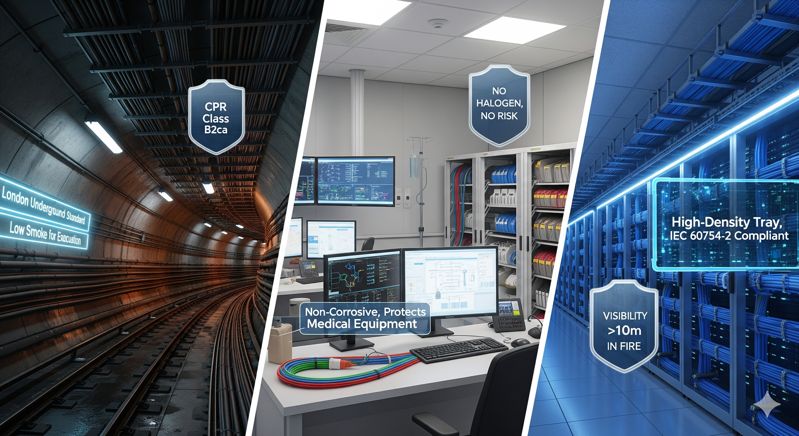
Feature | LSZH Cable | PVC Cable |
Smoke emission | Low | High |
Toxic gas release | None | Yes (chlorine, etc.) |
Fire spread resistance | Moderate | Moderate to good |
Cost | 10–30% higher | Lower |
Flexibility | Slightly stiffer | More flexible |
Compliance | IEC 60754, IEC 61034 | Not always compliant |
You don’t always need LSZH. But if people safety or equipment protection is a priority, it’s the better choice.
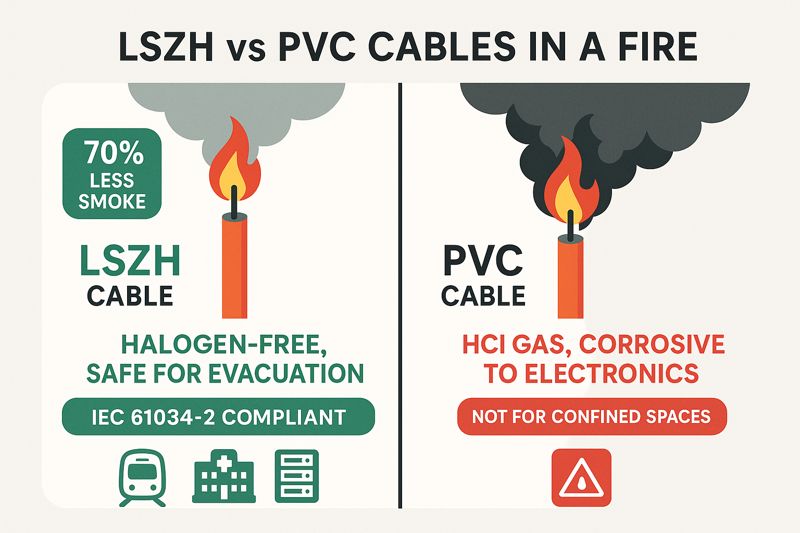
Using LSZH isn’t enough. You must ensure the cable meets recognized standards.
Key international standards include:
IEC 60754-1/-2: Tests for halogen acid gas emission
IEC 61034-2: Measures smoke density
EN 50575: EU construction product regulation for cables
NFPA 70 (NEC): In the U.S., check Article 800 for plenum-rated alternatives
In Europe, all cables used in construction must comply with the CPR (Construction Products Regulation). LSZH cables typically achieve Class B2ca or better in reaction-to-fire testing.
Always ask for test reports from suppliers. A real LSZH cable will have documentation — not just a label.
LSZH sounds great on paper. But in practice, there are trade-offs.
LSZH jackets are softer and more sensitive to abrasion. If you’re pulling cables through rough conduits, they can get damaged easily.
✅ Fix: Use conduit or cable trays. Avoid sharp bends. Add extra protection in high-friction areas.
Some LSZH compounds are susceptible to moisture accumulation over a period, which can result in the disturbance of data cable.
✅ Fix: LSZH cables that are protected from the outdoors or humidity should have moisture barrier or gel filling.
The majority of the LSZH cables are rated for 1 kV. There are limited options for projects which require medium voltage application (e.g., 10 kV).
Ask:
Is the cable for power, data or control?
Indoors or outdoors?
Is this in a high-traffic area or in a technical room?
Any localized on fire codes?
Request:
The testing reports of IEC 60754 and IEC 61034
The determination of CPR declaration of performance (for EU)
The compliance of RoHS and REACH
The fact that LSZH costs more upfront is absolutely true. But consider:
Lower risk = fewer insurance claims
Less downtime after fire events
Easier compliance with building inspectors
One hospital in Germany saved €200,000 in retrofitting costs by using certified LSZH cables from day one — avoiding failed inspections.
Do not work with unknown brands or Alibaba if the full traceability is not provided. Manufacturers such as Nexans, Prysmian, or CommScope, which are among the well-known and reputable ones, provide comprehensive documentation and support.
Pro tip: Ask for a trial spool before placing the massive purchase order. Perform the tests for bend radius, jacket strength, and label clarity.
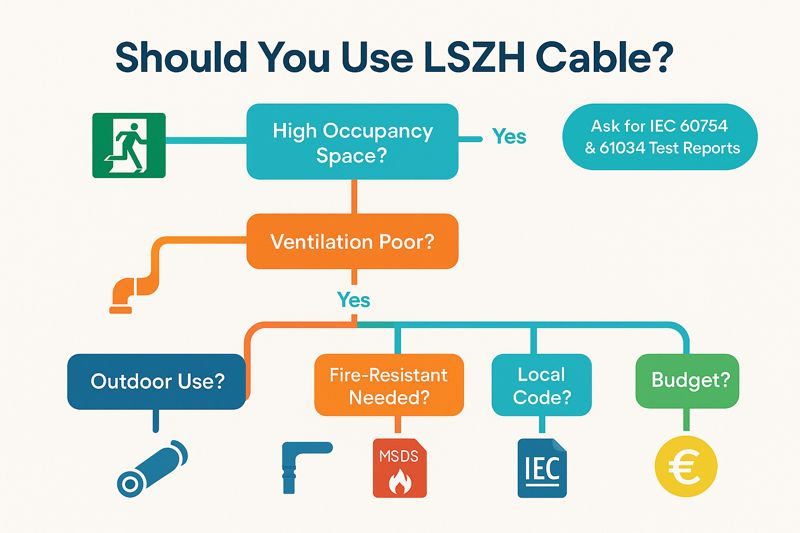
No. Plenum-rated cables (mainly CMP in the U.S.) have stringent regulations pertaining to their design in air-handling spaces where there are heavy restrictions for fire spread and smoke. Although both LSZH cables and plenum cables produce low amounts of smoke during the fire, they get tested under different set standards (UL 910 vs. IEC 61034). Unless locally approved, they are not interchangeable.
Yes, but only if the cable has UV protection and is moisture resistant. The jackets of the LSZH deteriorate if the sunlight is present. Ensure either that the LSZH is of outdoor-type grade or utilize conduit.
No. LSZH stands for the emitted smoke during fires and not fire resistance. When you require the cables that should keep working during a fire (such as for the emergency systems), get fire-resistant cables or circuit integrity cables (IEC 60331 compliant).
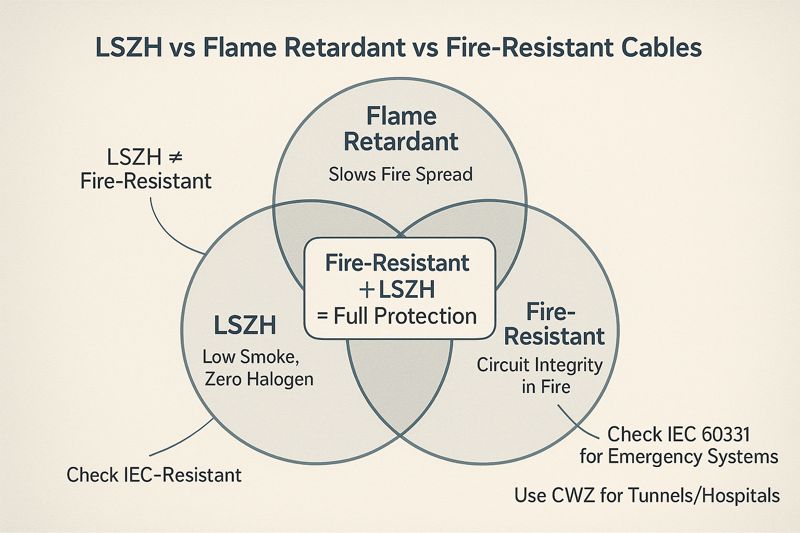
Some LSZH components may emit a mild sulfur-like smell when new. Although it isn’t toxic in nature, it disappears in days after release. If the smell persists or the irritation comes, stop the use and consult the MSDS.
It usually costs around 10% to 30% more than the PVC alternative. Talking about a 1000-meter run of Cat6 data cable, that’s a cost increase of $300-600. Weigh this against safety and compliance benefits.
Use LSZH cable when:
People safety is critical
Ventilation is limited
Building codes require low-smoke materials
You want to reduce long-term risk
Skip it when:
Budget is tight and risk is low (e.g., warehouse storage room)
Outdoor exposure is high and proper jacketing isn’t available
Only short cable runs are involved
There’s no one-size-fits-all. But for most modern commercial projects, LSZH is the safer, smarter default.
We’ve helped engineers in 30+ countries select the right LSZH cables for hospitals, transit hubs, and tech campuses. If you’re unsure about specs, certifications, or suppliers — send us your project details. We’ll give you a clear recommendation, no sales pitch.
Because safety shouldn’t be a gamble.
Contact us for more information
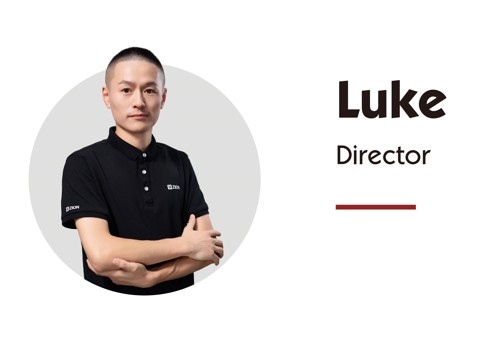
Luke Han is a Product Manager and Director at Zion Communication,
Specializing in fire, security, and alarm solutions. With extensive industry experience,
Dedicated to delivering high-performance, reliable products that are tailored to customer needs.
luke@zion-communication.com
0086 19883212162
